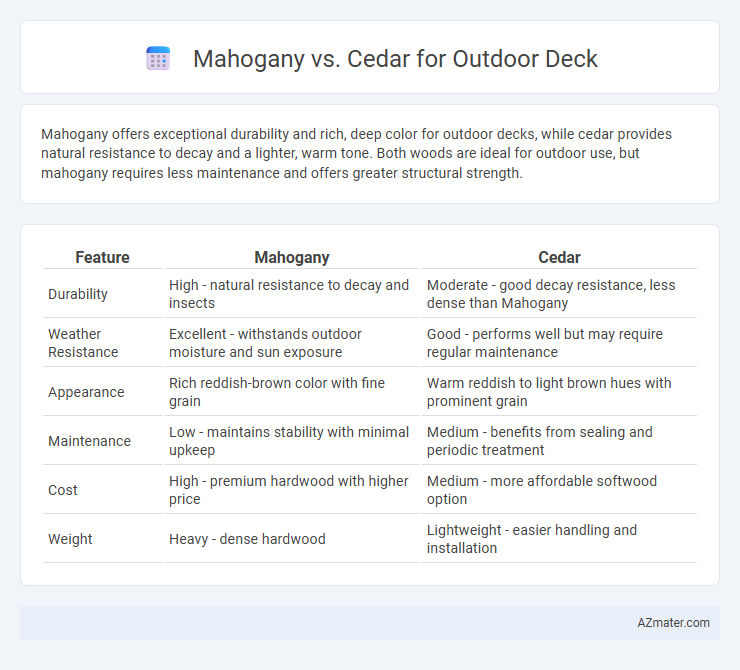Mahogany offers exceptional durability and rich, deep color for outdoor decks, while cedar provides natural resistance to decay and a lighter, warm tone. Both woods are ideal for outdoor use, but mahogany requires less maintenance and offers greater structural strength.
Table of Comparison
| Feature | Mahogany | Cedar |
|---|---|---|
| Durability | High - natural resistance to decay and insects | Moderate - good decay resistance, less dense than Mahogany |
| Weather Resistance | Excellent - withstands outdoor moisture and sun exposure | Good - performs well but may require regular maintenance |
| Appearance | Rich reddish-brown color with fine grain | Warm reddish to light brown hues with prominent grain |
| Maintenance | Low - maintains stability with minimal upkeep | Medium - benefits from sealing and periodic treatment |
| Cost | High - premium hardwood with higher price | Medium - more affordable softwood option |
| Weight | Heavy - dense hardwood | Lightweight - easier handling and installation |
Introduction to Mahogany and Cedar for Outdoor Decks
Mahogany and cedar are popular wood choices for outdoor decks due to their durability and natural resistance to decay. Mahogany offers a rich, deep color and tight grain structure, providing both aesthetic appeal and strength against weather conditions. Cedar is prized for its lightweight nature, aromatic properties, and excellent resistance to moisture and insects, making it a reliable option for outdoor decking.
Key Characteristics of Mahogany Wood
Mahogany wood features exceptional durability and natural resistance to rot and insect damage, making it ideal for outdoor decking. Its fine, straight grain and rich reddish-brown color enhance aesthetic appeal while offering stability against warping and shrinking. High density and natural oils contribute to mahogany's low maintenance requirements and long-lasting performance in outdoor environments.
Key Characteristics of Cedar Wood
Cedar wood is renowned for its natural resistance to rot, decay, and insect infestations, making it a durable choice for outdoor decks. Its lightweight texture and fine grain allow for easy handling and smooth finishing, while its rich aromatic oils provide a natural protective barrier against moisture. Cedar's ability to maintain dimensional stability in varying weather conditions ensures long-lasting structural integrity and minimal warping or cracking.
Durability and Longevity Comparison
Mahogany offers exceptional durability with natural resistance to rot, decay, and insect damage, making it a long-lasting choice for outdoor decks that can endure harsh weather conditions for decades. Cedar is also durable, valued for its natural oils that resist moisture and insect attacks, though it generally requires more maintenance than mahogany to maintain its longevity. Both woods provide excellent performance, but mahogany's denser grain typically results in a longer lifespan and enhanced structural integrity compared to cedar in outdoor environments.
Resistance to Weather and Insects
Mahogany offers superior resistance to moisture and insect damage due to its dense grain and natural oils, making it highly durable for outdoor decks in varying climates. Cedar is also naturally resistant to rot and insects, especially western red cedar, but its softer wood is more prone to dents and scratches compared to mahogany. Both woods perform well against weather exposure, yet mahogany's tighter grain provides enhanced weatherproofing and longevity for outdoor decking applications.
Maintenance and Care Requirements
Mahogany requires moderate maintenance, including regular sealing and occasional sanding to prevent weathering and color fading, while cedar demands more frequent sealing to protect against moisture and insect damage but naturally resists decay and rot. Both woods need annual cleaning to remove dirt and debris, yet cedar's softwood composition makes it more susceptible to scratches and dents compared to the denser, harder mahogany. Choosing mahogany can reduce long-term upkeep efforts, whereas cedar's natural oils provide some protection but necessitate ongoing vigilance to maintain its appearance and structural integrity in outdoor deck applications.
Aesthetic Appeal: Color and Grain Differences
Mahogany for outdoor decks offers a rich reddish-brown color with fine, straight grain patterns that deepen beautifully over time, enhancing a luxurious and warm aesthetic. Cedar showcases a lighter, more reddish to pale brown hue with a distinctive, more varied grain and natural knots, providing a rustic and natural charm. The color stability of mahogany tends to last longer compared to cedar, which may weather to a silver-gray patina if left untreated.
Cost Comparison: Mahogany vs Cedar
Mahogany decks typically cost between $25 and $35 per square foot, reflecting its premium durability and rich, reddish-brown color that ages gracefully. Cedar decks range from $15 to $30 per square foot, offering a more budget-friendly option with natural resistance to rot and insects but requiring more frequent maintenance. Factoring total cost of ownership, mahogany's longevity may offset its higher initial expense, while cedar's lower upfront price appeals to cost-conscious homeowners.
Environmental Impact and Sustainability
Mahogany and cedar are both popular choices for outdoor decking, but their environmental impact and sustainability differ significantly. Mahogany is often harvested from tropical rainforests, raising concerns about deforestation and habitat loss unless sourced from certified sustainable plantations, whereas cedar typically comes from more renewable temperate forests with faster growth rates. Cedar's natural resistance to decay and insects reduces the need for chemical treatments, making it a more eco-friendly option in terms of maintenance and longevity.
Which Wood is Best for Your Outdoor Deck?
Mahogany offers exceptional durability and rich reddish-brown color, making it a premium choice for outdoor decks that demand both strength and aesthetic appeal. Cedar is naturally resistant to decay and insects, with a lighter, warm tone and a more affordable price point, ideal for budget-conscious homeowners seeking low maintenance. Choosing between mahogany and cedar depends on your priorities for longevity, appearance, and cost, with mahogany excelling in durability and cedar providing natural resilience and softer beauty.

Infographic: Mahogany vs Cedar for Outdoor Deck
 azmater.com
azmater.com